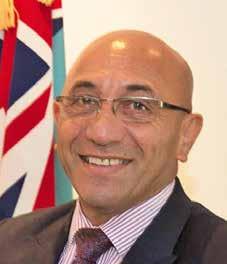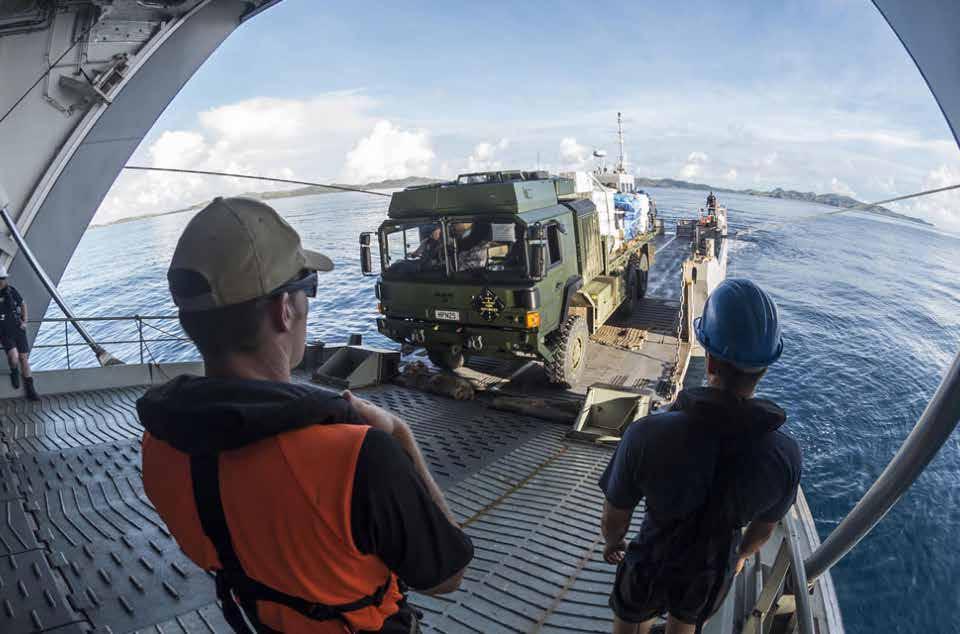
5 minute read
Speech: Minister launches Advancing Pacific Partnerships
Defence Minister Ron Mark launched the Advancing Pacific Partnerships 2019 Defence Assessment at Te Papa on 20 October, articulating an alignment of defence capability to the needs of the region.
Aligning with the Coalition Government’s Pacific Reset, this Defence Assessment outlines how Defence will partner with New Zealand’s Pacific Island neighbours and invest in Pacific regional security architecture. In this extract from the launch speech the minister focuses on regional security architecture and optimising Defence’s capacity and capability to deliver in the Pacific.
Last year, our Strategic Defence Policy Statement recognised that in an increasingly complex strategic environment in the Pacific, active engagement in support of regional security architecture will increase in importance.
Advancing Pacific Partnerships underscores the importance of investing in Pacific regional security architecture. Transnational challenges require regional approaches, and regionalism elevates Pacific voices.

We are guided by the Boe Declaration, a statement by the Pacific Islands Forum leaders that highlights the importance of collective action. It is our compass for Defence efforts to advance regional security.
As I noted earlier, the Boe Declaration “reaffirms that climate change remains the single greatest threat to the livelihoods, security and wellbeing of the peoples of the Pacific.” New Zealand Defence has been proactive and responsive to this affirmation by Pacific leaders.
For those of us in New Zealand and in the Pacific, the many varied manifestations of climate change are affecting communities today. Too often for our Pacific partners, the impacts on lives and livelihoods are severe.
Last December, I released another Defence Assessment, titled The Climate Crisis: Defence readiness and responsibilities. It reinforces New Zealand’s view that climate change is one of the greatest security challenges of our time.
Over time there will be an increased requirement for our Defence and other security forces to respond with humanitarian assistance and disaster relief, more search and rescue missions. We have made capability investment decisions on this basis, something I will address more fully in a few moments.
This May, at the South Pacific Defence Ministers’ Meeting, regional defence leaders unanimously supported recommendations for future work on defence, security, and climate change.
I am proud of the strides that New Zealand Defence has made in this area, from elevating these issues in a range of international forums to advancing a South Pacific Defence Ministers’ Meeting study focused on climate change and security in the Pacific; from creating new responsibilities in our Ministry, to co-hosting, together with the US Indo-Pacific Command, the Pacific Environmental Security Forum in Wellington in May.
This is just the beginning of our efforts on the climate crisis with more commitments on the horizon, and the Pacific has New Zealand Defence’s commitment to be your faithful and constant partner in these efforts…
Finally, New Zealand Defence is aiming to optimise our delivery of the Advancing Pacific Partnerships approach.
A major way we are taking our Pacific priority forward is by increasing the Defence Force’s capability and capacity to deliver operations and other activities in the Pacific.
This is at the heart of our ability to be a reliable and responsive partner. This requirement, this solemn obligation we have to our region, especially in the context of climate change, forms the foundation of the Force that will be delivered through the Defence Capability Plan 2019, which I announced in June.

Photo courtesy of New Zealand Defence Force
This capability plan comprises a range of investments critical to enhancing our ability to respond in the Pacific, including the introduction of a second, more capable sealift vessel.
Since the Canterbury first deployed for humanitarian and disaster relief following the impact the 2009 earthquake and tsunami in Samoa, the ship has been a critical component of New Zealand Defence Force activities in the Pacific.
In response to cyclone Pam in Vanuatu in 2015, over the course of 27 days the ship provided personnel, medical stores, construction materials, food and fresh water to local populations impacted by the cyclone. The Canterbury was also critical to recovery efforts following Cyclone Winston in Fiji.
The importance of a strong sealift capability is inherent in the Pacific. A second amphibious vessel will more than double our capacity and effectiveness in this area.
The Defence Capability Plan also calls for growing the size of the New Zealand Army by 1500 people, bringing the total to 6000 by the year 2035.
Increasing the size of the Army will provide for longer sustainment of operations, and a greater ability to contribute resources across our areas of responsibility. It is another way in which we will be better postured to deliver in partnership with Pacific countries.
In addition, two of our Coalition Government’s recent, major capability decisions also have important bearing on our operations and activities in the Pacific. This includes the C-130 J-30 Super Hercules and the Boeing P-8A Poseidon.
Our current C-130H Hercules are among the most Pacific-focused capabilities of the Defence Force, crucial to transporting New Zealand Defence Force people and equipment, as well as our partners, to operations and activities around the region.
The Capability Plan provides for these aircraft to be replaced within the next five years. Government has announced the selection of the C-130 J-30 Super Hercules as the preferred option, ensuring that this capability is maintained for decades to come.
In addition, New Zealand will acquire four Boeing P-8A Poseidon maritime patrol aircraft to replace the ageing P-3K2 Orion fleet. The P-8A will bring enhanced capability to the roles performed by the Orions including search and rescue, disaster response, resource protection, and environmental and marine resource monitoring in New Zealand, the Pacific, and beyond.
This capability will be complemented by an Enhanced Maritime Awareness Capability. The Coalition Government’s Defence Capability Plan 2019 includes additional capabilities that will contribute to New Zealand’s maritime domain awareness, including Maritime Satellite Surveillance and Long Endurance Unmanned Aerial systems. Maritime security is fundamental to New Zealand’s national security and to our contributions to Pacific security.
The above is an excerpt from the Minister’s speech. For the full speech visit https:// www.beehive.govt.nz/speech/speech-launchadvancing-pacific-partnerships.










